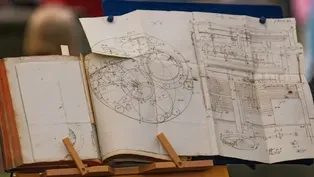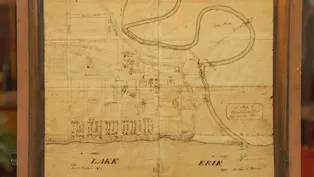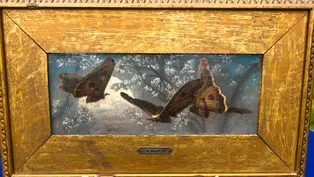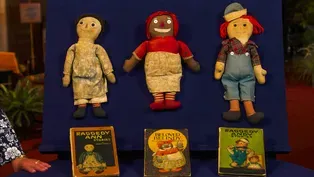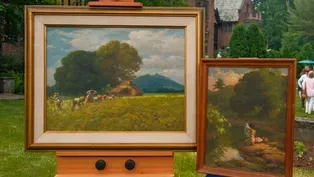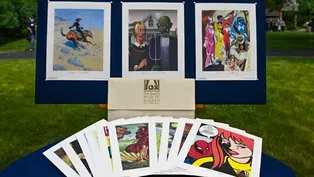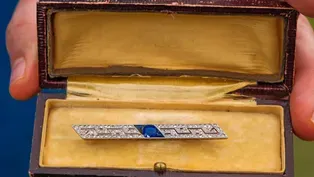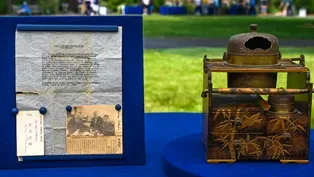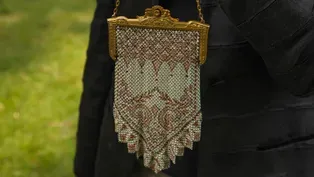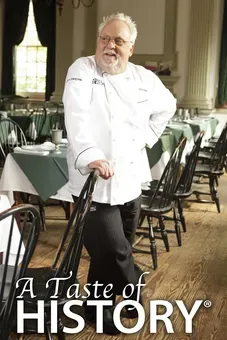
Appraisal: Frederick Rhead Bowl & George Ohr Pot
Clip: Season 28 Episode 15 | 4m 22sVideo has Closed Captions
Appraisal: Frederick Rhead Bowl & George Ohr Pot
Watch David Rago’s appraisal of a Frederick Rhead bowl & George Ohr pot in Stan Hywet Hall & Gardens, Hour 3.
Problems with Closed Captions? Closed Captioning Feedback
Problems with Closed Captions? Closed Captioning Feedback
Funding for ANTIQUES ROADSHOW is provided by Ancestry and American Cruise Lines. Additional funding is provided by public television viewers.

Appraisal: Frederick Rhead Bowl & George Ohr Pot
Clip: Season 28 Episode 15 | 4m 22sVideo has Closed Captions
Watch David Rago’s appraisal of a Frederick Rhead bowl & George Ohr pot in Stan Hywet Hall & Gardens, Hour 3.
Problems with Closed Captions? Closed Captioning Feedback
How to Watch Antiques Roadshow
Antiques Roadshow is available to stream on pbs.org and the free PBS App, available on iPhone, Apple TV, Android TV, Android smartphones, Amazon Fire TV, Amazon Fire Tablet, Roku, Samsung Smart TV, and Vizio.
Buy Now
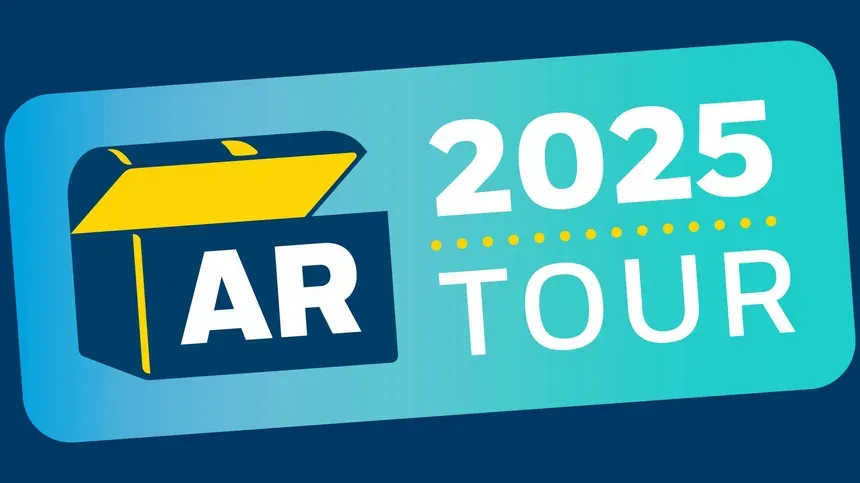
ANTIQUES ROADSHOW 2025 Tour!
Enter now for a chance to win free tickets to ANTIQUES ROADSHOW's 2025 Tour! Plus, see which cities we're headed to!Providing Support for PBS.org
Learn Moreabout PBS online sponsorshipAPPRAISER: So there's a piece that's, uh, certainly in the style of George Ohr.
GUEST: Right.
APPRAISER: And a piece by Frederick Rhead-- and you got this where?
GUEST: Uh, I was at a country auction and it was sitting on a stepladder.
And I bought it with a little coffee pot for six dollars.
APPRAISER: Very nice.
GUEST: About 30-- about 30 years ago.
APPRAISER: How did you acquire that one?
GUEST: A friend of mine, he had contacted me.
He had an antique shop, and, um, somebody had brought in a box of pottery, and he didn't deal in pottery, and... APPRAISER: So how many pieces were in the lot that you bought?
GUEST: Probably about ten pieces or so, give or take.
APPRAISER: And you paid how much for the ten pieces?
GUEST: Think about $300.
This piece was there, and I thought, "Well, I'll, I'll hang on to that."
Essentially, I have negative amount of money in this.
I sold the other stuff for more than what I paid for everything.
It's probably been ten or twelve years... APPRAISER: Okay.
GUEST: ...I've had that.
APPRAISER: These two potters were two of the top three potters in America during the art pottery era, which is the first quarter of the 20th century, but diametrically opposed.
Uh, Frederick Rhead was an Englishman who was m, almost a graphic designer, more than a potter.
Came to America and then traveled, eventually, across the country.
What's interesting is that Rhead, in a way, followed or took the Arts and Crafts Movement with him as it started in England, came to the Eastern U.S., and traveled across until it ended in California.
Ohr was the Mad Potter of Biloxi-- totally different.
He was as, as unbuttoned as Rhead was buttoned up.
And so I, I like the fact that you have two examples by two of the luminaries-- if they're real, of course-- two of the luminaries, but they're so vastly different from one another.
Let's start with the Rhead piece, and this is real.
Not a lot of Rhead has been faked.
This is from his Santa Barbara studio.
It would have been Rhead and his wife and a small studio in the artist colony that was Santa Barbara from about 1914 to about 1916.
And this is his famous squeeze bag decoration.
At 19 years old in Staffordshire, at Wardle, he was the head of the department, the artistic director, and they were already using this squeeze bag technique, also called slip trail, where you outline a decoration in relief, squeezing slip as though a baker were decorating a cake.
GUEST: Okay.
APPRAISER: And then Rhead augmented it by putting enamel colors inside the squeeze bag areas to give it very sharp distinction.
Nice matte-glazed, three-color squeeze bag piece.
It's dirty, it needs to be cleaned.
GUEST: Okay.
APPRAISER: This was used as a bulb pot, which is really what its function was.
GUEST: Right, right.
APPRAISER: Consequently, over the years, there are calcium deposits inside the bowl.
There are things that can take those out.
The work is extremely rare.
Especially to know that you have a piece that was done from start to finish and decorated by the master...
GUEST: Ah.
APPRAISER: ...it's a really good thing.
Now, George Ohr, working f, f, roughly from the 1880s until...
The last known dated pot was 1907.
The problem with Ohr is that he's the most inimitable of the potters of, of any era in this country, and yet he was the guy that was most often faked.
GUEST: Okay.
APPRAISER: So how do we know if a piece is fake or not in George Ohr?
The mark is an indication.
Although these block stamp marks, like on this piece, people have replicated those using printer's type.
The quality of the throwing, if it's a piece from the ground up, is something you look for: paper-thin, perfectly thrown.
Dirty bottom-- Ohr was not a clean potter.
He, he was not fastidious, I should say.
So the bottoms of his pots often look like this.
And the main thing for me with George Ohr is, uh, do I recognize the glaze?
GUEST: Okay.
APPRAISER: Because I've seen fakes that were so good, that if I didn't recognize the glaze from other pots that I've seen over the last 50 years, then it probably isn't right.
Fortunately, I've seen this glaze.
Okay?
This is a real piece of George Ohr.
GUEST: Ah!
Wow.
(chuckles) APPRAISER: Okay?
And I would date this to about 1898, 1899.
The George Ohr piece, at auction, would bring somewhere between $2,000 and $3,000.
GUEST: Oh, my goodness.
APPRAISER: The Rhead piece at auction, it depends on how well this cleans up.
GUEST: Okay.
APPRAISER: For now, I would say between $7,500 and $10,000.
GUEST: (exhales) APPRAISER: If it really cleaned up well, in the right auction, it's between $10,000 and $20,000.
GUEST: Oh, my God.
(laughing) Oh, wow!
APPRAISER: And both have a, at least a brief association with Ohio.
Rhead decorated at Roseville and Weller in Zanesville.
GUEST: Okay.
APPRAISER: And Ohr, before he started potter, potting, toured potteries to see how other companies were making pots.
GUEST: Mm-hmm.
APPRAISER: So both of them have at least a loose association with Ohio, the pottery state.
And that's where we are now.
Appraisal: 1792 Ferdinand Berthoud Manuscript
Video has Closed Captions
Appraisal: 1792 Ferdinand Berthoud Manuscript (3m 25s)
Appraisal: 1832 Cleveland Manuscript Map
Video has Closed Captions
Appraisal: 1832 Cleveland Manuscript Map (3m 25s)
Appraisal: 1859 Oil on Wooden Panel Painting
Video has Closed Captions
Appraisal: 1859 Oil on Wooden Panel Painting (3m 41s)
Appraisal: 1894 Ohio Maritime Diorama
Video has Closed Captions
Appraisal: 1894 Ohio Maritime Diorama (2m 40s)
Appraisal: 1920 Beloved Belindy, Raggedy Ann & Andy Group
Video has Closed Captions
Appraisal: Beloved Belindy, Raggedy Ann & Andy Group, ca. 1920 (2m 52s)
Appraisal: 1926 Ernst Heinrich Roth Amati Copy Violin
Video has Closed Captions
Appraisal: 1926 Ernst Heinrich Roth Amati Copy Violin (3m 10s)
Appraisal: 1955 Fernando Amorsolo Oil Paintings
Video has Closed Captions
Appraisal: 1955 Fernando Amorsolo Oil Paintings (4m 21s)
Appraisal: 1968 Mexico Olympics Poster
Video has Closed Captions
Appraisal: 1968 Mexico Olympics Poster (3m 41s)
Appraisal: 1995 Fox Kids Promotional Print Set
Video has Closed Captions
Appraisal: 1995 Fox Kids Promotional Print Set (3m 33s)
Appraisal: Art Deco Sapphire & Diamond Brooch, ca. 1915
Video has Closed Captions
Appraisal: Art Deco Sapphire & Diamond Brooch, ca. 1915 (3m 27s)
Appraisal: Japanese Lacquer Tabako-bon, ca. 1900
Video has Closed Captions
Appraisal: Japanese Lacquer Tabako-bon, ca. 1900 (5m 15s)
Appraisal: Mandalian Metal Mesh Purse, ca. 1915
Video has Closed Captions
Appraisal: Mandalian Metal Mesh Purse, ca. 1915 (1m 3s)
Appraisal: Thurman Munson-signed Baseball, ca. 1975
Video has Closed Captions
Appraisal: Thurman Munson-signed Baseball, ca. 1975 (2m 39s)
Providing Support for PBS.org
Learn Moreabout PBS online sponsorshipSupport for PBS provided by:
Funding for ANTIQUES ROADSHOW is provided by Ancestry and American Cruise Lines. Additional funding is provided by public television viewers.


